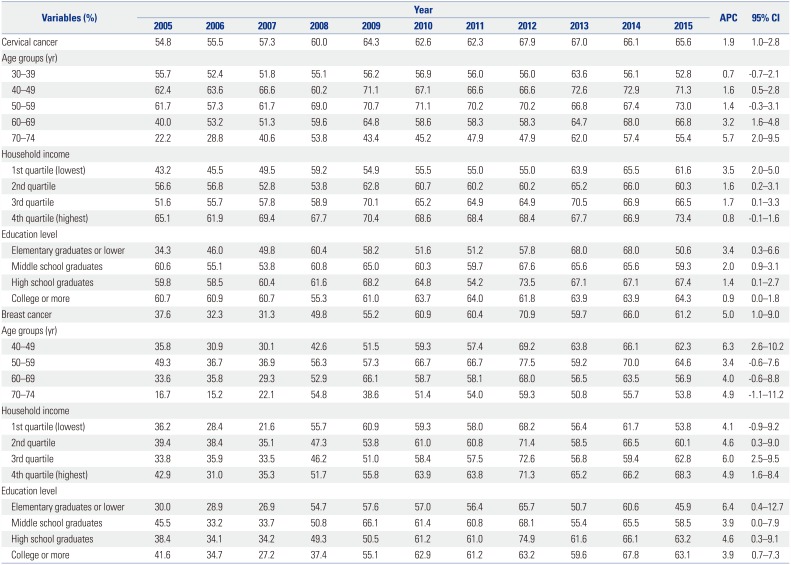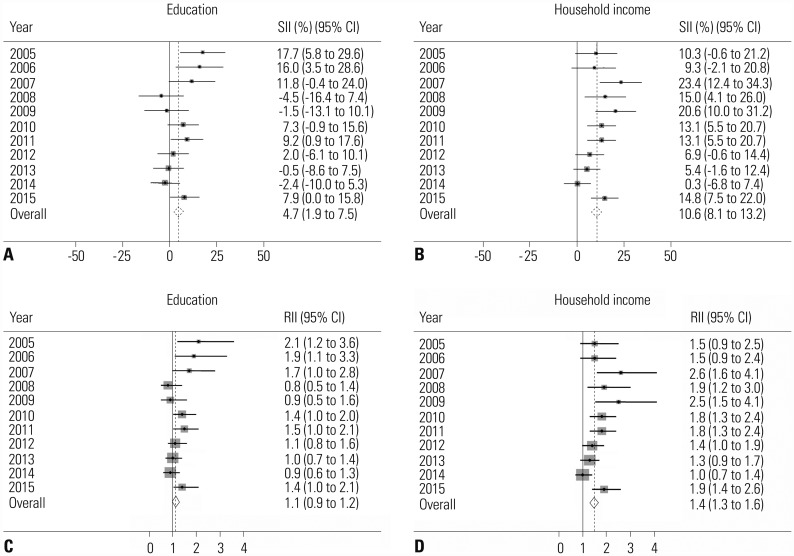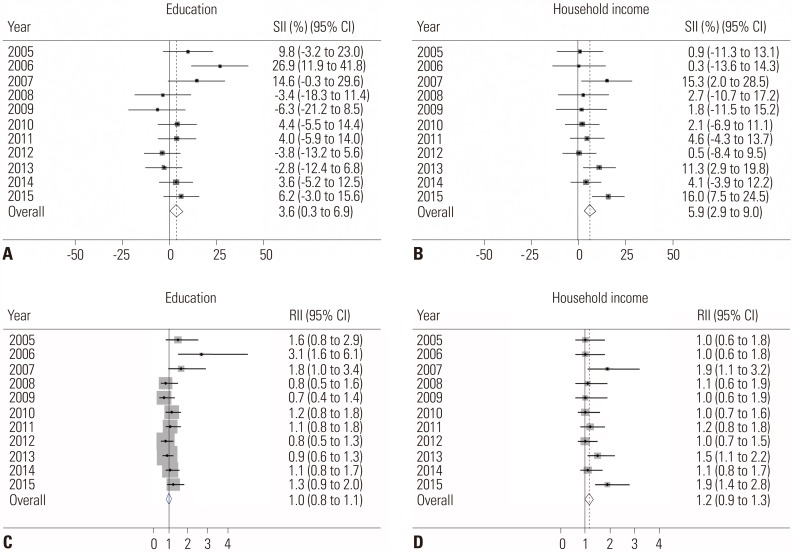1. Ferlay J, Soerjomataram I, Dikshit R, Eser S, Mathers C, Rebelo M, et al. Cancer incidence and mortality worldwide: sources, methods and major patterns in GLOBOCAN 2012. Int J Cancer. 2015; 136:E359–E386. PMID:
25220842.

2. Teng AM, Atkinson J, Disney G, Wilson N, Blakely T. Changing socioeconomic inequalities in cancer incidence and mortality: Cohort study with 54 million person-years follow-up 1981-2011. Int J Cancer. 2017; 140:1306–1316. PMID:
27925183.

3. Lundqvist A, Andersson E, Ahlberg I, Nilbert M, Gerdtham U. Socioeconomic inequalities in breast cancer incidence and mortality in Europe-a systematic review and meta-analysis. Eur J Public Health. 2016; 26:804–813. PMID:
27221607.

4. Palència L, Espelt A, Rodríguez-Sanz M, Puigpinós R, Pons-Vigués M, Pasarín MI, et al. Socio-economic inequalities in breast and cervical cancer screening practices in Europe: influence of the type of screening program. Int J Epidemiol. 2010; 39:757–765. PMID:
20176587.
5. Wharam JF, Zhang F, Xu X, Landon BE, Ross-Degnan D. National trends and disparities in cervical cancer screening among commercially insured Women, 2001-2010. Cancer Epidemiol Biomarkers Prev. 2014; 23:2366–2373. PMID:
25128400.

6. Drolet M, Boily MC, Greenaway C, Deeks SL, Blanchette C, Laprise JF, et al. Sociodemographic inequalities in sexual activity and cervical cancer screening: implications for the success of human papillomavirus vaccination. Cancer Epidemiol Biomarkers Prev. 2013; 22:641–652. PMID:
23549400.

7. Miller JW, Plescia M, Ekwueme DU. Public health national approach to reducing breast and cervical cancer disparities. Cancer. 2014; 120(Suppl 16):2537–2539. PMID:
25099895.

8. Smith-Bindman R, Miglioretti DL, Lurie N, Abraham L, Barbash RB, Strzelczyk J, et al. Does utilization of screening mammography explain racial and ethnic differences in breast cancer? Ann Intern Med. 2006; 144:541–553. PMID:
16618951.

9. Jung KW, Won YJ, Oh CM, Kong HJ, Lee DH, Lee KH. Community of Population-Based Regional Cancer Registries. Cancer statistics in Korea: incidence, mortality, survival, and prevalence in 2014. Cancer Res Treat. 2017; 49:292–305. PMID:
28279062.

10. Choi E, Lee YY, Yoon HJ, Lee S, Suh M, Park B, et al. Relationship between cancer worry and stages of adoption for breast cancer screening among Korean women. PLoS One. 2015; 10:e0132351. PMID:
26186652.

11. Yoo KY. Cancer control activities in the Republic of Korea. Jpn J Clin Oncol. 2008; 38:327–333. PMID:
18407932.

12. Suh M, Choi KS, Park B, Lee YY, Jun JK, Lee DH, et al. Trends in cancer screening rates among Korean men and women: results of the Korean National Cancer Screening Survey, 2004-2013. Cancer Res Treat. 2016; 48:1–10. PMID:
25943324.

13. Kim S, Kwon S, Subramanian SV. Has the National Cancer Screening Program reduced income inequalities in screening attendance in South Korea? Cancer Causes Control. 2015; 26:1617–1625. PMID:
26335263.

14. Lee M, Park EC, Chang HS, Kwon JA, Yoo KB, Kim TH. Socioeconomic disparity in cervical cancer screening among Korean women: 1998-2010. BMC Public Health. 2013; 13:553. PMID:
23742100.

15. Park MJ, Park EC, Choi KS, Jun JK, Lee HY. Sociodemographic gradients in breast and cervical cancer screening in Korea: the Korean National Cancer Screening Survey (KNCSS) 2005-2009. BMC Cancer. 2011; 11:257. PMID:
21682886.

16. Renard F, Demarest S, Van Oyen H, Tafforeau J. Using multiple measures to assess changes in social inequalities for breast cancer screening. Eur J Public Health. 2014; 24:275–280. PMID:
23994840.

17. Lee JT, Huang Z, Basu S, Millett C. The inverse equity hypothesis: does it apply to coverage of cancer screening in middle-income countries? J Epidemiol Community Health. 2015; 69:149–155. PMID:
25311479.

18. Chiou ST, Wu CY, Hurng BS, Lu TH. Changes in the magnitude of social inequality in the uptake of cervical cancer screening in Taiwan, a country implementing a population-based organized screening program. Int J Equity Health. 2014; 13:4. PMID:
24405587.

19. OECD. Education at a Glance 2017: OECD Indicators. Paris: OECD Publishing;2017.
20. Sabik LM, Tarazi WW, Bradley CJ. State Medicaid expansion decisions and disparities in women's cancer screening. Am J Prev Med. 2015; 48:98–103. PMID:
25441234.

21. Moser K, Patnick J, Beral V. Inequalities in reported use of breast and cervical screening in Great Britain: analysis of cross sectional survey data. BMJ. 2009; 338:b2025. PMID:
19531549.









 PDF
PDF ePub
ePub Citation
Citation Print
Print



 XML Download
XML Download